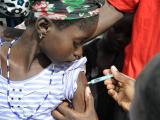Sep 13, 2012 (CIDRAP News) – A detailed look at California children during the state's large pertussis outbreak in 2010 revealed that protection from the diphtheria, tetanus, and pertussis (DTaP) vaccine wanes 5 years after kids receive their last dose, which could be fueling outbreaks.
The findings come on the heels of a warning earlier this summer from the US Centers for Disease Control and Prevention (CDC). The agency, along with state health department partners, found an unusual illness spike in Washington state 13- and 14-year-olds, which also raised the possibility of waning pertussis (whooping cough) vaccine protection.
The United States is headed toward its worst pertussis year in decades, CDC officials said in July, and two states—Washington and Colorado—have declared epidemics.
The new study on pertussis in California children, published today in the New England Journal of Medicine (NEJM), is the first to focus on the cohort of children who have received only the DTaP since birth.
In the late 1990s the United States transitioned from a whole-cell pertussis vaccine to an acellular version, due to a fairly high rate of minor side effects with the older vaccine.
The large size of California's pertussis outbreak allowed researchers at Kaiser Permanente Vaccine Study Center (KPVSC) to examine the relationship between the time since pertussis vaccination and how likely children were to test positive for the disease. The CDC recommends five DTaP doses for children, given at 2, 4, and 6 months; at 15 to 18 months; and when the youngster enters school, between 4 and 6 years of age.
The study focused on Kaiser Permanente's northern California population, which includes 3.3 million members in a system that has electronic medical records and a central laboratory. It compared 277 children between ages 4 and 12 years who tested positive for pertussis with 3,318 kids who tested negative, with a separate comparison involving 6,086 matched controls.
The researchers analyzed the risk of pertussis in California children from 2006 to 2011 in relation to the time since their last dose of DTaP vaccine, finding that protection wanes 42% each year after the fifth dose (odds ratio of 1.42 [95% confidence interval, 1.21 to 1.66]).
The amount of protection that remained after 5 years depended on the initial effectiveness of the vaccine, according to the study. For example, if the initial effectiveness was 90%, it would drop to 42% after 5 years.
Pertussis incidence was highest in kids ages 8 to 11 years, suggesting that the drop-off in efficacy after the fifth dose in schoolchildren played a role in fueling and sustaining California's pertussis outbreak. Investigators wrote that this observation was surprising, because teenagers are typically considered a pertussis reservoir and have been disproportionately affected in previous outbreaks.
They noted that the sharp increase in 8- to 11-year-olds, followed by a sharp pertussis drop in 12- to 15-year-olds, hasn't been seen in the epidemiology of unvaccinated people in previous outbreaks.
Nicola Klein, MD, PhD, who led the study and co-directs the KPVSC, said in a Kaiser Permanente press release that the findings suggest that pertussis control measures may need to be reconsidered.
"Prevention of future outbreaks may be best achieved by developing new pertussis-containing vaccines or reformulating current vaccines to provide long-lasting immunity," she said. However, Klein emphasized that the DTaP is effective and is still an important tool for protecting children and communities. "Following current CDC recommendations remains important," She said.
Tom Clark, MD, MPH, a medical epidemiologist with the CDC's Meningitis and Vaccine Preventable Diseases Branch, told CIDRAP News that researchers have already illustrated the waning protection from an epidemiologic perspective, and now this study and others soon to be published are measuring the degree of risk from the reduced vaccine effectiveness.
Clark coauthored a July report in Morbidity and Mortality Weekly Report (MMWR) that highlighted the illness spike in 13- and 14-year-olds in Washington's recent outbreak
Health officials are also seeing waning protecting with the tetanus, diphtheria, and pertussis (Tdap) booster recommended for 11-year-old children, he said, adding that protection gaps from both vaccines appear to be fueling the current epidemic.
The nation's number of pertussis cases reported so far this year—27,726—has surpassed the final number of 27,550 reported for 2010, making 2012 the hardest-hit year in decades, Clark said. The updated pertussis total appears in today's issue of MMWR.
Scientists don't have a clear understanding of why the vaccine doesn't protect very well, and developing a better vaccine could be a long way off, because there's not much in the pipeline, Clark said. "A lot of us are saying 'start now,' " he added.
In the meanwhile, pertussis vaccination is still the best way to fight the disease and is still a very important tool, especially since there is a lot of ongoing pertussis activity, he said.
Michele Roberts, MPH, with the Washington State Department of Health immunization program, has been involved with the state's epidemiologic investigations of pertussis activity and took note of the new NEJM findings. She said the vaccine protection drop-off the Kaiser team found is another piece of the puzzle that will help experts better understand how to use the vaccine to control outbreaks.
She said the next step is to evaluate the duration of protection from the Tdap vaccine, adding that studies are already under way to shed light on that issue. Pertussis is a difficult disease to understand, Roberts said, because natural infection doesn't provide long-term immunity, and there are still several unanswered scientific questions.
Roberts echoed the point that health officials are still embracing use of the vaccine. She said its short-term protection is good and it is useful for helping prevent the spread of the disease, especially in outbreak settings, and to mitigate the severity of infections.
Klein NP, Bartlett J, Rowhani-Rahbar A, et al. Waning protection after fifth dose of acellular pertussis vaccine in children. N Engl J Med 2012 (published online Sep 13) [Abstract]
See also:
Sep 12 Kaiser Permanente press release
Jul 19 CIDRAP News story "CDC: Pertussis numbers suggest vaccine protection gap"
Jul 20 MMWR report
Sep 14 MMWR notifiable diseases and mortality tables
















